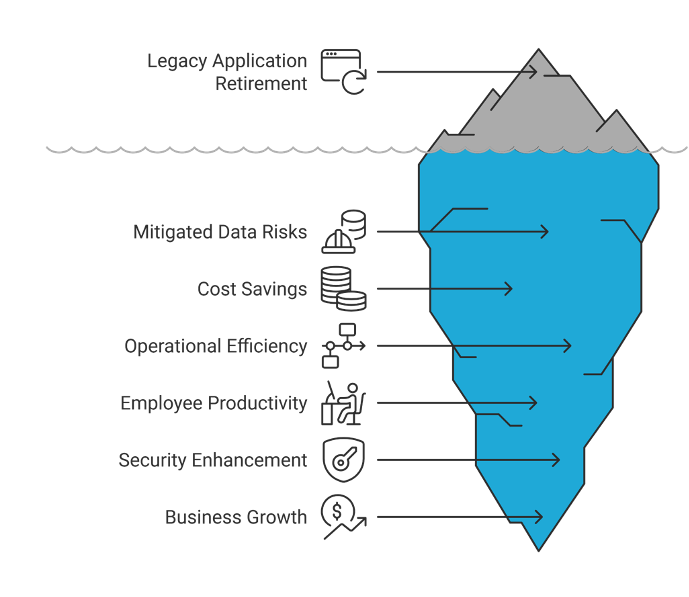
Unlocking Hidden ROI: The Strategic Benefits of Legacy Application Retirement (Save $1 million)
Blog Commentary:

The very legacy applications that powered enterprise growth for decades have transformed into costly barriers to business advancement. According to a Forrester survey, close to 60% of CTOs find their outdated technology stack expensive and insufficient for supporting modern applications. Beyond reducing costs, this approach addresses the significant opportunity cost of maintaining outdated systems by freeing critical resources—time, computing power, and skilled personnel. These reclaimed resources can then be redirected toward driving digital transformation, enhancing operational efficiency, and strengthening competitive advantage. This blog explores the hidden ROI of retiring these legacy applications, highlighting both the direct and indirect financial benefits of strategic application retirement.
Understanding the True Cost of Legacy Applications
Legacy applications represent outdated software systems that continue to operate within an organization despite being technologically obsolete or inefficient. These systems, often complex and deeply integrated into business processes, pose significant financial and operational challenges for enterprises attempting to maintain technological relevance. Understanding these costs is crucial for justifying application retirement.
Direct Costs
Maintaining legacy systems can increase a company’s annual expenses by 10–15%, solely for upkeep. Keeping legacy applications incurs substantial expenses, including ongoing maintenance, hardware and software upgrades, and licensing fees. These costs not only strain IT budgets but also divert resources from strategic initiatives.
- Maintenance Expenses: Maintaining legacy applications often requires considerable financial investment. Organizations face ongoing costs related to the following:
- Technical Support: Legacy systems typically require specialized knowledge that may not be readily available among current IT staff. This often necessitates hiring external consultants or specialists, which can be costly.
- Frequent Repairs and Updates: As technology evolves, legacy applications may need frequent repairs to address bugs or compatibility issues with newer systems. Each repair can incur labor costs and downtime, impacting productivity.
- Customization Costs: Many legacy systems are customized to meet specific business needs. However, as business requirements change, these customizations may need to be updated or re-engineered, leading to further expenses.
- Hardware and Software Upgrades: Legacy applications often run on outdated hardware and software that can no longer support modern business operations effectively. The costs associated with this include:
- Obsolete Hardware: Maintaining old servers and infrastructure can be expensive due to the rising costs of parts and the difficulty in finding compatible components. As hardware ages, it becomes more prone to failure, leading to unexpected replacement costs.
- Software Compatibility Issues: Legacy applications may require specific versions of operating systems or other software that are no longer supported. Upgrading these systems can lead to additional licensing fees and compatibility testing, further inflating costs.
- Integration Challenges: Connecting legacy applications with new systems often requires additional middleware or custom development work, adding complexity and cost to IT projects.
- Licensing Fees: Many legacy applications come with ongoing licensing fees that represent a significant financial burden. These fees can include:
- Annual Licensing Costs: Organizations often pay hefty annual fees for software licenses that may provide limited value if the application is rarely used or has become obsolete.
- User Licenses: As the number of users increases, so do licensing fees. Maintaining licenses for outdated applications can lead to unnecessary expenses that could be redirected toward more efficient solutions.
- Vendor Lock-In: Many legacy systems are tied to specific vendors, leading to a lack of flexibility in negotiating pricing or exploring alternative solutions. This vendor lock-in can prevent organizations from seeking more cost-effective options.
Indirect Costs
While direct costs associated with legacy applications are often quantifiable, the indirect costs can be more challenging to measure but are equally impactful. These hidden expenses can significantly affect an organization’s overall performance and profitability. Here’s a closer look at the various indirect costs tied to maintaining legacy systems.
- Data Breach Risks: Legacy systems often lack modern security features, making them vulnerable to data breaches. Approximately 70% of data breaches occur in organizations that rely on legacy systems for their IT operations.
- Compliance Risks: Organizations must adhere to various regulations concerning data privacy and security, such as GDPR or HIPAA. Legacy systems often struggle to meet these compliance requirements due to outdated technology and processes.
- Performance and Productivity Limitations: Old systems can slow down operations, affecting employee productivity and customer satisfaction. A report highlights that 90% of businesses face limitations in growth and improved efficiency because of outdated technology.
- Technical Debt Accumulation: An analysis of 160 organizations found that an average application with 300,000 lines of code carried $1,083,000 in technical debt, or $3.61 per line—making it nearly impossible to address without halting projects.
- Reputational Damage: Inefficient systems can lead to poor customer experiences, harming an organization’s reputation.
Opportunity Costs
The concept of opportunity cost is crucial when evaluating the resources allocated to maintaining legacy systems. Resources such as time, computing power, and personnel could be redirected toward more innovative projects that drive growth and efficiency. Here are some potential opportunities lost due to maintaining these outdated systems:
- Innovation Initiatives: Resources tied up in maintaining legacy applications could instead support new product development or enhancements that align with market demands.
- Talent Utilization: IT personnel focused on troubleshooting legacy systems could be engaged in strategic projects that leverage emerging technologies like AI or cloud computing.
- Efficiency Improvements: Time spent on fixing bugs or compatibility issues could be redirected towards optimizing workflows or improving customer service processes.
- Computing Infrastructure: Legacy systems often monopolize valuable computing resources. Modern cloud-based alternatives could reduce energy consumption, enable rapid scaling during peak demands, provide flexibility for testing new features, support data analytics and business intelligence initiatives, etc.
Financial Benefits of Legacy Application Retirement
Direct Cost Savings
Retiring legacy applications reduces infrastructure expenses, eliminates licensing fees, and lowers maintenance and support costs, freeing up resources for strategic initiatives. With fewer outdated systems to manage, IT teams can focus on innovation rather than troubleshooting, resulting in streamlined operations and significant financial savings that directly impact the bottom line.
Indirect ROI Considerations
Legacy application retirement enhances operational efficiency, boosts employee productivity, and strengthens security. Modern systems streamline workflows, reduce compliance risks, and mitigate data breaches, fostering customer trust. These improvements not only drive innovation and scalability but also contribute to long-term business growth by enabling organizations to adapt quickly to evolving market demands.
Calculating Application Retirement ROI
To accurately assess the ROI of retiring legacy applications, organizations must meticulously identify costs associated with decommissioning, estimate savings and operational benefits, and calculate ROI metrics. To effectively calculate the ROI from retiring legacy applications, organizations should follow a structured approach:
- Identify Costs: The first step is to identify all costs associated with maintaining the legacy application. This includes direct costs, such as maintenance expenses, hardware upgrades, and licensing fees, as well as indirect costs, like data breach risks and compliance issues. A comprehensive cost analysis provides a clear picture of the financial burden posed by outdated systems. The matrix shown below depicts different elements contributing to the total cost inquired by your legacy application.
- Estimate Savings and Benefits: Next, organizations should estimate potential savings and benefits resulting from the application’s retirement. Key performance indicators (KPIs) such as cost reduction percentages, efficiency improvement rates, security enhancement indicators, brand reputation, customer satisfaction, and operational agility metrics provide tangible benchmarks for evaluating success.
| Hardware Costs | Application Licensing Costs | Data Center Cost |
| Database Costs | Networking Cost | IT Labor Costs |
| Electricity Costs | Storage Costs | Number of ‘Objects’ per Application |
To illustrate the financial implications of retiring a legacy application, consider the following hypothetical case study:
| Items | Cost (per annum) | |
|---|---|---|
| Hardware Costs | $100,000 | The total cost of maintaining legacy applications for 3 years: $1.35 Million |
| Database Costs | $150,000 | |
| Electricity | Costs $10,000 | |
| Networking Cost | $15,000 | |
| Storage Costs | $25,000 | |
| Data Centre Cost | $100,000 | |
| IT Labor Costs | $40,000 | |
| Application Licensing | Costs$10,000 | |
| Number of ‘Objects’ per Application | 300,000,000 |
*Objects refer to different types of data entities, such as documents, records, databases, and other forms of both structured and unstructured data.
*These numbers are merely estimates; the costs of real-world implementations may vary.
Calculate ROI
Once costs and savings are established, organizations can calculate their ROI using the standard formula:
In this formula, Net Benefits represent the total savings minus the costs incurred during the retirement process. This calculation provides a percentage that reflects the financial return on investment.
The Future of Legacy Systems
With emerging technologies like AI and cloud computing reshaping the IT landscape, organizations must consider how they will manage their legacy applications moving forward. Predictions suggest a shift towards more integrated solutions that prioritize security and compliance while enhancing operational agility. By assessing these costs against potential savings from application retirement, organizations can make informed decisions about their IT strategies.
Bottom Line
Retiring legacy applications is not merely a cost-cutting measure; it represents a strategic opportunity to unlock hidden ROI. By understanding both direct and indirect benefits, organizations can enhance operational efficiency while ensuring compliance and security. Organizations should take proactive steps to evaluate their legacy applications’ performance and potential for retirement. Embracing modernization can lead to significant financial benefits and position businesses for future success.
Vishnu Jayan is a tech blogger and Senior Product Marketing Executive at Solix Technologies, specializing in enterprise data governance, management, security, and compliance. He earned his MBA from ICFAI Business School Hyderabad. He creates blogs, articles, ebooks, and other marketing collateral that spotlight the latest trends in data management and privacy compliance. Vishnu has a proven track record of driving leads and traffic to Solix. He is passionate about helping businesses thrive by developing positioning and messaging strategies for GTMs, conducting market research, and fostering customer engagement. His work supports Solix’s mission to provide innovative software solutions for secure and efficient data management.






